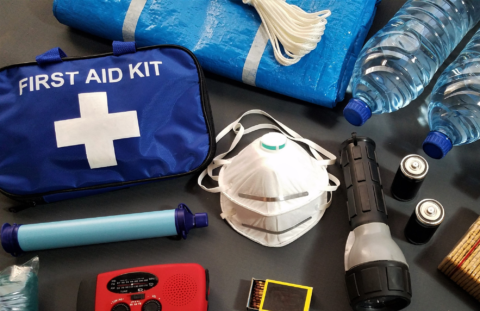Preparing for a Disaster

Are you prepared? In light of the recent natural disasters impacting California, Sequoia Healthcare District hosted a series of Town Hall meetings covering disaster preparedness. In this article, we will be discussing the main takeaways to help keep you, your family and the community safe in the event of a disaster.
Prepare a go-bag
One of the most important ways you can get prepared is by packing a go-bag filled with essential items (first aid kit, water, food, etc.). A few minutes packing these items now will save you valuable time during a disaster. Click here for a general checklist of items that should be included in your go-bag.
Since emergencies and disasters can happen anywhere, it is critical that you not only have a go-bag ready at home but also in your vehicle and/or at work in case you are away from your home when a disaster strikes. Remember to pack your phone charger and other devices for communication since your phone battery may get low.
Create a plan
To help you get started, attend a CERT (Community Emergency Response Team) class taught by your local fire department. These courses are free of charge and will give you an in-depth look at disaster prep. Click here to learn more.
Once you have built a better understanding of disaster prep through the CERT courses, it is time to start personalizing your plan to you. Talk to your family and friends and create a plan. For example, have a set meeting point that is easy to remember and central to your area. Furthermore, agree on your method of communication should you be separated in a disaster. If you have a pet(s), don't forget to include them in your plan too.
Keep in mind that first responders may not be able to reach you until days following a disaster. It is critical that you have a plan in place to keep you, your family and neighborhood safe in the meantime.
Get Prepared at Home
The following steps can help make your home safer in case of an emergency/disaster:
- Replace your smoke alarms/detectors every 10 years. This is imperative since they do not last forever!
- Test your smoke alarm every month if possible. If every month is not feasible for you, replace the battery every year on a date that is easy to remember like the 4th of July. This way you can have peace of mind that your smoke detector is operational.
- Indoor space heaters need 3 feet of space around them so keep them 3 feet from the wall and furniture.
Get familiar with the processes in your area
- Participate in ShakeOut Day. Register today for this event happening October 21st and learn more about earthquake safety.
- Know your zone. Put your address in here and get your zone so you know when to evacuate.
- Sign up for SMCAlert. SMC Alert is a free alert notification system available to all in San Mateo County. Sign up here to receive alerts for urgent/emergency situations.
Thank you to everyone who attended the Disaster Prep Town Hall meetings. It is never too early to get prepared. Follow us on social media @shealthdistrict and periodically check our website for more updates and resources on disaster preparedness.
